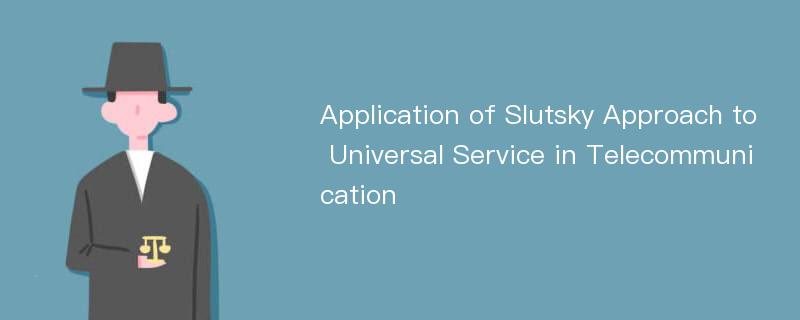
论文摘要
Universal Service is as old as the history of telecommunications. At the start of this century it was meant by the interconnection but after the passage of time it had changed its meaning. The present concept of the Universal Service came in picture in the mid of this century. In many countries of the world Universal Service Fund Programs were formed. These US Funds were actually indirect taxation on the consumers of the low cost areas. It is not justified to subsidize the high cost area consumers at the cost of low cost area consumers. This type of the practice is not justified by Economics.Commodity taxation causes the consumer to alter his utility as he is worse off and he will consume less of taxed good and will substitute this taxed commodity with untaxed commodity. It creates deadweight loss. Whereas by implementing the General tax there is no dead weight loss. If the tax is necessary then it should be General tax so as to reduce the community loss or consumer welfare.
论文目录
ABSTRACTACKNOWLEDGMENTSChapter 1:Literature Review1.1 Introduction1.2 Competition1.3 Cross subsidies1.4 Consumer welfare1.5 Rural subsidies1.6 Economist's perspectives on Universal ServiceChapter 2:Introduction2.1 Objective of the Dissertation2.2 Definitions of the Universal Service2.2.1 Defined by ITU2.2.2 Defined by FCC2.2.3 Defined by European Union2.3 History of the Universal Service2.3.1 Theodore Veil Concept2.3.2 Willis-Graham Act 19212.3.3 The Communication Act of 19342.3.4 Telecommunication Act of 19962.4 Formation of Universal Service Fund2.5 Funding Mechanism2.5.1 Who gets Funds?2.5.2 Funding not by General TaxChapter 3:Failure of Universal Service Fund Programs in United States of America3.1 Analysis of current situation3.1.1 Telephone Penetration Rate by Income3.1.2 Overall Household Telephone Penetration3.1.3 Telephone Penetration in High Cost Areas3.2 Impact of cable telephony3.3 Impact of Commercial Mobile Radio Services(CMRS)3.4 Concluding RemarksChapter 4:Universal Service Regime in United Kingdom4.1 Background4.1.1 Telecommunication Act 19844.1.2 Office of Communications(OFCOM)4.1.3 The Electronic Communications(Universal Service)Order 20034.2 Scope of Universal Service4.2.1 Payphones4.2.2 Use of Mobile4.2.3 Broadband Obligations4.3 Objective of Universal Service4.4 Universal Service Methodology4.4.1 Special low cost schemes4.4.2 Public call boxes4.4.3 Services for customers with disabilities4.4.4 Providing a phone line4.5 Concluding remarksChapter 5:Universal Service Regime in Developing Countries5.1 CHINA5.1.1 Introduction5.1.2 Trend in Telecommunication Development5.1.3 Development in Wireless Technology5.1.4 Development in Rural Areas5.1.5 Telecommunication Law5.2 INDIA5.2.1 Introduction5.2.2 Telecommunication Development5.2.3 Universal Access through VPTs(Village Public Telephone)5.2.4 Development in Cellular Network5.3 PAKISTAN5.3.1 Introduction5.3.2 Background5.3.3 Goals for Universal Service5.3.4 Development in Telecommunication SectorChapter 6:Theoratical Framework6.1 Effect of taxes6.2 Mathematical Explanation6.2.1 Mathematical Evaluation of Income Effect6.3 Dead Weight Loss from Commodity Taxation6.3.1 Measuring dead weight loss using Equivalent Variation:6.3.2 Measuring dead weight loss using Compensating Variation:Chapter 7:Alternatives to the Universal Service Fund Programs7.1 Cross subsidization7.2 Commercial mobile and radio services(CMRS)7.3 Introduction of Competition7.4 Cable telephonyChapter 8:Research Contribution and ConclusionAppendix A:ReferencesAppendix B:Different measurement of demandAppendix C:Published Papers
相关论文文献
Application of Slutsky Approach to Universal Service in Telecommunication
下载Doc文档
